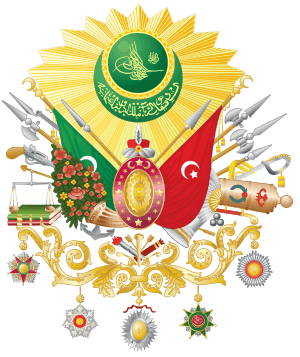Şehzade Ahmed Kemaleddin
Şehzade Ahmed Kemaleddin (Ottoman Turkish: شهزادہ احمد کمالالدین; 16 July 1848 - 26 April 1905) was an Ottoman prince, son of Sultan Abdulmejid I and his seventh wife Verdicenan Kadın.
| Şehzade Ahmed Kemaleddin | |||||
|---|---|---|---|---|---|
| Born | 16 July 1848 Old Çırağan Palace, Istanbul, Ottoman Empire | ||||
| Died | 26 April 1905 (aged 56) Beşiktaş Palace, Istanbul, Ottoman Empire | ||||
| Spouse | Sezadil Hanım | ||||
| Issue | Atiyetullah Sultan Münire Sultan | ||||
| |||||
| House | Ottoman | ||||
| Father | Abdulmejid I | ||||
| Mother | Verdicenan Kadın | ||||
| Religion | Sunni Islam | ||||
Early years
Şehzade Ahmed Kemaleddin was born on 16 July 1848 in the Old Çırağan Palace. His father was Sultan Abdulmejid I, and his mother was Verdicenan Kadın,[1] the daughter of Prince Kaytuk Giorgi Achba and Princess Yelizaveta Hanım. He had a full sister, Münire Sultan, three years elder than him.[2]
Kemaleddin and his brothers, Princes Mehmed Reşad (future Sultan Mehmed V), Mehmed Burhaneddin, and Ahmed Nureddin were circumcised in 1856.[3][4] After Abdulmejid's death in 1861, Kemaleddin and his mother settled in the Feriye Palace.[2][5]
Kemaleddin like his brothers, Sultan Murad V and Şehzade Ahmed Nureddin joined Proodos ("Progress" in Greek) Masonic lodge in 1875. This lodge was founded in the Beyoğlu district of Istanbul in 1867, as an associate of the French lodge “Grand Orient.” The lodge’s rituals were conducted in both Turkish and Greek.[6]
After his half-brother Sultan Abdul Hamid II accended the throne in 1876, Kemaleddin became second in line to the throne.[7]
Relationship with Sultan Abdul Hamid II
The relations between Sultan Abdul Hamid II and Prince Kemaleddin were sour. And so, he believed that Murad should be restored to the throne.[8] It is said that in the days when Abdul Hamid was a prince, Prince Ahmed Kemaleddin once ran into pressing financial difficulties. He applied to the wealthy Abdul Hamid for funds and even sent over valuable objects as security for a loan. But Abdul Hamid replied, "I'm no petty money changer! Since he wants to pawn something for money, let him try the money changes in the Caviar Building!" Prince Ahmed Kemaleddin took offence at this, and ever afterwards relations between the two were frosty.[9]
In 1878, Kemaleddin, and his siblings including his brother Prince Selim Suleiman, and sisters Princess Fatma, and Princess Seniha, and Seniha's husband Mahmud Celaleddin Pasha, were all involved in the Ali Suavi incident with the objective of restoring Murad to the throne.[10]
Personal life
Kemaleddin's only wife was Fatma Sezadil Hanım. She was an Abkhazian,[11] and was born in 1856,[1] or 1860 in Caucasus.[11] The two married on 23 April 1876 in the Dolmabahçe Palace. She was the mother of princesses Atiyetullah Sultan, and Münire Sultan. She died on 9 February 1943 in Istanbul.[11]
Kemaleddin owned an eighteenth-century mansion in Çengelköy in the silent hills of Bosphorus. Abdul Hamid then bought this estate for Prince Mehmed Vahideddin (future Mehmed VI), and registered the deed of the property in his name.[12]
Death
Ahmed Kemaleddin was killed by the order of his brother, Abdul Hamid II, on 26 April 1905[13] in the Beşiktaş Palace. He was buried in the royal mausoleum of Yahya Efendi, Istanbul.[1] He was honoured posthumously, after the 1908 resolution, for his liberal leanings.[7]
Issue
Şehzade Ahmed Kemaleddin had two daughters:
- Atiyeullah Sultan (1878 – 1878, buried in Yahya Efendi Cemetery);
- Münire Sultan (Dolmabahçe Palace, 5 April 1880 – Nice, France, 7 October 1939), buried Nice, France, married Mehmed Salih Pasha on 10 January 1907 and had issue;
Ancestry
| Ancestors of Şehzade Ahmed Kemaleddin | |||||||||||||||||||||||||||||||||||||||||||||||||||||||||||||||||||||||||||||||||||||||||||||||||||||||||||||||||||||||||||||||||||||||||||||||||||||||||||||||||||||||||||||||||||||||||||||||||||||||||||||||||||||||||||||||||||||||||||||||||||||||||||||||||||||||||||||||||||||||||||||||||||||||||||||||||||||||||||||||||||||||||||||||||||||||||||||||||||||||||||||||||||||||||||||||||||||||||||||||||||||||||||||||||||||||||||||||||||||||||||||||||||||||||||||||||||||||||||||||||||||||||||||||||||||||||||||||||||||||||||||||||||||||||||||
|---|---|---|---|---|---|---|---|---|---|---|---|---|---|---|---|---|---|---|---|---|---|---|---|---|---|---|---|---|---|---|---|---|---|---|---|---|---|---|---|---|---|---|---|---|---|---|---|---|---|---|---|---|---|---|---|---|---|---|---|---|---|---|---|---|---|---|---|---|---|---|---|---|---|---|---|---|---|---|---|---|---|---|---|---|---|---|---|---|---|---|---|---|---|---|---|---|---|---|---|---|---|---|---|---|---|---|---|---|---|---|---|---|---|---|---|---|---|---|---|---|---|---|---|---|---|---|---|---|---|---|---|---|---|---|---|---|---|---|---|---|---|---|---|---|---|---|---|---|---|---|---|---|---|---|---|---|---|---|---|---|---|---|---|---|---|---|---|---|---|---|---|---|---|---|---|---|---|---|---|---|---|---|---|---|---|---|---|---|---|---|---|---|---|---|---|---|---|---|---|---|---|---|---|---|---|---|---|---|---|---|---|---|---|---|---|---|---|---|---|---|---|---|---|---|---|---|---|---|---|---|---|---|---|---|---|---|---|---|---|---|---|---|---|---|---|---|---|---|---|---|---|---|---|---|---|---|---|---|---|---|---|---|---|---|---|---|---|---|---|---|---|---|---|---|---|---|---|---|---|---|---|---|---|---|---|---|---|---|---|---|---|---|---|---|---|---|---|---|---|---|---|---|---|---|---|---|---|---|---|---|---|---|---|---|---|---|---|---|---|---|---|---|---|---|---|---|---|---|---|---|---|---|---|---|---|---|---|---|---|---|---|---|---|---|---|---|---|---|---|---|---|---|---|---|---|---|---|---|---|---|---|---|---|---|---|---|---|---|---|---|---|---|---|---|---|---|---|---|---|---|---|---|---|---|---|---|---|---|---|---|---|---|---|---|---|---|---|---|---|---|---|---|---|---|---|---|---|---|---|---|---|---|---|---|---|---|---|---|---|---|---|---|---|---|---|---|---|---|---|---|---|---|---|---|---|---|---|---|---|---|---|---|---|---|---|---|---|---|---|---|---|---|---|---|---|---|---|---|---|---|---|---|---|---|---|---|---|---|---|---|---|---|---|---|---|---|---|---|---|---|---|---|---|---|---|---|---|---|---|---|---|---|---|---|---|---|---|---|---|---|---|---|---|---|---|---|---|---|---|---|---|---|---|---|---|---|---|---|---|---|---|---|---|---|---|---|---|---|---|---|---|---|---|---|---|---|---|---|---|---|---|
| |||||||||||||||||||||||||||||||||||||||||||||||||||||||||||||||||||||||||||||||||||||||||||||||||||||||||||||||||||||||||||||||||||||||||||||||||||||||||||||||||||||||||||||||||||||||||||||||||||||||||||||||||||||||||||||||||||||||||||||||||||||||||||||||||||||||||||||||||||||||||||||||||||||||||||||||||||||||||||||||||||||||||||||||||||||||||||||||||||||||||||||||||||||||||||||||||||||||||||||||||||||||||||||||||||||||||||||||||||||||||||||||||||||||||||||||||||||||||||||||||||||||||||||||||||||||||||||||||||||||||||||||||||||||||||||
References
- Adra, Jamil (2005). Genealogy of the Imperial Ottoman Family 2005. pp. 8.
- Harun Açba (2007). Kadın efendiler: 1839-1924. Profil. pp. 34–5. ISBN 978-9-759-96109-1.
- Özer, İlbeyi (2005). Avrupa yolunda batılaşma ya da batılılaşma: İstanbul'da sosyal değişimler. Truva Yayınları. p. 29. ISBN 978-9-756-23734-2.
- Arslan, Mehmet (2008). Osmanlı saray düğünleri ve şenlikleri: Manzum sûrnâmeler. Sarayburnu Kitaplığı. p. 329. ISBN 978-9-944-90563-3.
- Brookes 2010, p. 59.
- Brookes 2010, p. 69 n. 44.
- Brookes 2010, p. 283.
- Brookes 2010, p. 59 n. 32.
- Brookes 2010, p. 59 n. 31.
- Brookes 2010, p. 76 and n. 51, 52.
- Woronzow, Salome (September 20, 2016). Şehzade Zevceleri. Osmanlı Hanedanı Gelinleri 1850 - 1923. GRIN Verlag. p. 4. ISBN 978-3-668-30031-6.
- Bardakçı, Murat (2017). Neslishah: The Last Ottoman Princess. Oxford University Press. p. 7. ISBN 978-9-774-16837-6.
- Kandemir, Feridun; Yıldırım, Tahsin (2006). Tüntüncübaşı Şükrü anlatıyor: Vahdeddin'in son günleri. Yağmur Yayınları. p. 84. ISBN 978-9-757-74764-2.
Source
- The Concubine, the Princess, and the Teacher: Voices from the Ottoman Harem. University of Texas Press. 2010. ISBN 978-0-292-78335-5.
External links
- "Genealogy of the Ottoman Family". Retrieved 19 August 2008.
- Family Tree, descendants of Sultan Mahmud II. Retrieved 2014-10-04.
